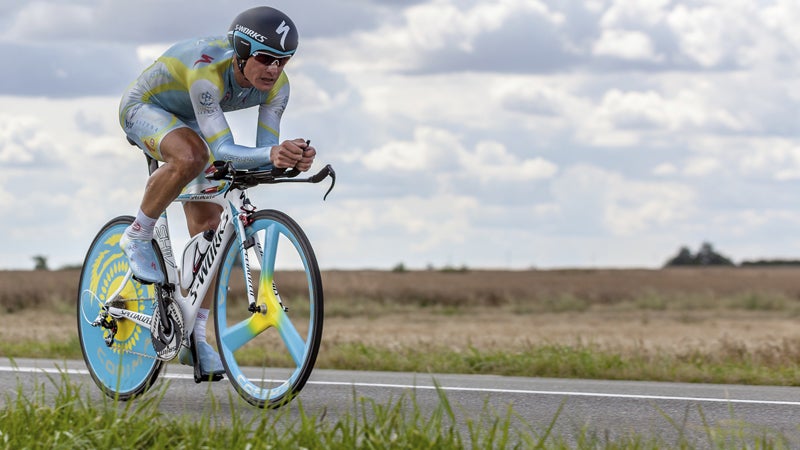The Union Cycliste Internationale (UCI), cycling’s governing body, recently announced that it’s —an event that pits a cyclist against the clock to see how far he can ride in 60 minutes.
Previously riders attempting to beat the record had to do so on bikes without any aerodynamic benefits, which ruled out shaped tubes, deep section rims, drop handlebars, and anything resembling a modern time trial position. Because of these limitations, Eddy Merckx’s 1972 record of 49.431km (30.715 miles) was long considered the mark to beat.
Under the new rules, any attempt at the hour record moving forward will be bound by the regulations that apply to endurance track bikes (including equipment and position) in place at the time of the ride. That means modern TT positioning and aerodynamics will now be fair game, and it moves the benchmark up to the 2005 record of Czech rider Ondrej Sosenka, who rode 49.7 kilometers (30.882 miles).
Though this all may sound like eye-glazing esoterica, the decision has some interesting, broad-based implications for the cycling world.
Right now, the UCI—and professional cycling in general—could use some expansive thinking to rescue the sport from the doping morass.
First of all, it’s important to remember that not too long ago the hour record was a prestigious accomplishment that appealed to fans in much the same way as the quest for the four-minute mile did in the 1950s.
The ping-pong record trading of the ‘90s between Graham Obree and Chris Boardman, as told in the biopic , captivated the public—even people outside the bike-racing niche. The record gained so much cachet that even some of the biggest names in the peloton, including Tony Rominger and Miguel Indurain, tried their hands at it.
That period culminated with Boardman’s 56.375-kilometer record in 1996. But the UCI cut the heyday short when it amended the rules to disallow records set during the period because the organization felt technology—including unorthodox aerodynamics such as Obree’s superman position—was making for an uneven playing field.
The move away from the anachronistic 1972 standard—as well as the simple act of explicitly clarifying the rules at all—should help reignite interest among the top pros. And with all the bad press cycling’s had in recent years, that’s a good thing. Wouldn’t it be great to see some of the most respected names in the sport battling it out for the honors? An Obree-Boardman-style rivalry could help reignite some interest in road cycling as a whole among the public.
Before the rule change, —including time trial world champions Fabian Cancellara and Tony Martin—had talked about taking a run at the record. Cancellara is reported to have put his since the ruling, presumably because Trek had been developing gear for him based on the old standards. Meanwhile, Tour de France champ Bradley Wiggins sounds more interested than ever in .��
But the import of the rule change reaches beyond the hour record. The UCI has come under fire for all sorts of ineptitude and malfeasance in recent years, and it is widely considered too stodgy and dogmatic regarding equipment. Hopefully, this move on the hour record signals that the organization, under the direction of its new president, Brian Cookson, is ready to move into the future.��
“This new rule is part of the modernisation (sic) of the UCI Equipment Regulation,” said Brian Cookson in the news about the changes to the hour record. “Today there is a general consensus that equipment used in competition must be allowed to benefit from technological evolution where pertinent. This kind of evolution is positive for cycling generally and for the hour record in particular.”
That’s refreshing talk, and there have been other promising signals in this vein, including word that the UCI is considering the legalization of .
I’ve also heard rumors in recent months that there could soon be changes coming to the minimum weight for race bikes (currently set at 6.8 kilograms, or 14.99 pounds). Many have criticized this 14-year-old standard because it means professionals are constrained to equipment that is inferior to that of many recreational riders. Just imagine if the general public drove nicer cars than F1 drivers or piloted finer boats than America’s Cup sailors.
Of course no equipment regulation is all that important. But the fact that the UCI is thinking about these things hopefully signals that it’s in the process of much-needed reform, both in terms of equipment and beyond. As Ralph Waldo Emerson once said, “Consistency is the hobgoblin of small minds.” And right now, the UCI—and professional cycling in general—could use some expansive thinking to rescue the sport from the doping morass.
In the meantime, I just hope we see a few top pros throw their legs over an hour attempt. It might be the closest we’ll ever come to seeing an in-form Cancellara race against Eddy Merckx at his prime. Let the betting and conjecture begin.


